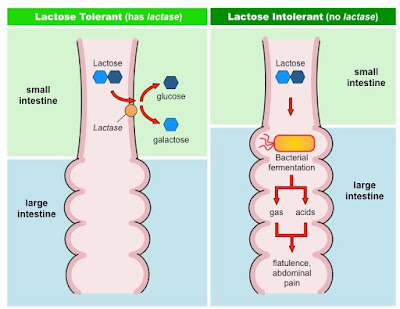 |
| http://aprilseventheblog.blogspot.com/2015/08/lets-talk-about-lactose-intolerance.html |
Being lactose intolerant, or having lactose malabsorption, means that an individual's body is not able to properly digest the lactose sugar that is present in milk and other dairy products. This condition can cause some discomfort in the individual, such as nausea, diarrhea, bloating, gas, and/or abdominal cramps after eating or drinking a dairy product (1).
When mammals are born, they will generally live their first couple of months off of drinking milk that is produced by their mothers, therefore, the enzyme lactase is produced in the small intestines so that the baby can break down the lactose (sugar molecule) in the milk (1).
 |
| http://ib.bioninja.com.au/standard-level/topic-2-molecular-biology/25-enzymes/lactose-intolerance.html |
On the left, there is a normal flow of lactose through the small and large intestine. As you can see, the lactose molecule comes into the small intestine and immediately becomes followed by a lactase enzyme. This lactase enzyme breaks the lactose molecule into two products, glucose and galactose. Glucose is a type of simple sugar, or monosaccharide, that you get from food that your body uses for energy (2). Galactose is also a simple sugar that is not really essential on its own, or from the consumption of dairy products, and can actually be synthesized in the body from glucose. When galactose binds to glucose it "make[s] lactose (in breast milk), to lipids to make glycolipids (for example, molecules that constitute blood groups A, B, and AB) or to proteins to make glycoproteins (for example, in cell membranes)" (3). Based on that information, we can see that the lactose in milk is very important because that lactose breaks up to create glucose and galactose. Back to the image above on the right, we can see the flow of lactose in an individual that does not produce the lactase enzyme or just not enough of it. The lactose will not be absorbed into the bloodstream (via the small intestine), therefore, the bacteria in the large intestine will interact with the undigested lactose creating the symptoms I listed above.
 |
| https://www.reddit.com/r/MapPorn/comments/26dqdz/percentage_of_people_with_lactose_intolerance2535/ |
 |
| https://www.freeman-pedia.com/earlymodern |
Increasing in age: You do not generally see young children and babies having this condition because they drink milk when they are being breastfed. They also need milk to get their calcium as they continue growing, which is why this condition is generally found in teens and adults. There are many alternatives to getting the necessary nutrients found in milk which is why it does not seem like a big deal in modern times. The gene in some adults will just turn off the production of lactase leading to their condition.
Ethnicity: As shown from the map above, being lactose intolerant is more common in certain areas of the world than others. If the gene that codes for the production of lactase was not used in your ancestors, then the chances of you not producing the enzyme lactase is increased. Therefore, lactose intolerance can be passed on genetically.
Disease affecting the small intestine: Bacterial overgrowth, celiac disease, and Crohn's disease can all cause problems in the small intestine that prevents you from being able to break down the lactose sugar.
Premature birth: In the third trimester, an infant will begin to perfect its small intestines by developing lactase-producing cells, but if an infant is born prematurely, he or she would not have developed those cells efficiently.
If you are lactose intolerant and are thinking about how you will get those essential nutrients that others are able to get, do not worry, there are plenty of alternatives.
 |
| https://www.justshortofcrazy.com/enjoying-dairy-with-lactaid-a-giveaway/ |
Enjoy!
 |
| https://memegenerator.net/instance/20113774/dwight-schrute-false-all-lactose-intolerant-people-crave-ice-cream |
 |
| https://memegenerator.net/instance/52839083/dangerously-austin-powers-eating-dairy-when-youre-lactose-intolerant-i-too-like-to-live-dangerously |
References:
1) This website provides information about being lactose intolerant, such as what it is, the symptoms, causes, and risk factors associated with the condition. Mayo Clinic Staff. Mayo Clinic. Lactose intolerance. https://www.mayoclinic.org/diseases-conditions/lactose-intolerance/symptoms-causes/syc-20374232. Updated April 21, 2018. Accessed March 26, 2019.
2) This website answers the question of what glucose is. Reviewed by Michael Dansinger. WebMD. What is Glucose? https://www.webmd.com/diabetes/qa/what-is-glucose. Updated August 13, 2016. Accessed March 26.
3) This website gives a lot of information about galactose sugars, such as what it is, what food products is it found in, its function, how it interacts with other molecules, etc. Nutrients Review. Galactose. http://www.nutrientsreview.com/carbs/monosaccharides-galactose.html. Published October 2016. Accessed March 26, 2019.
4) This website provides information about what being lactose intolerant means and what supplements/ alternatives there are for teens and young adults that definitely need their calcium intake for growth. Reviewed by J. Fernando del Rosario, MD. Teens Health from Nemours. Lactose Intolerance. https://kidshealth.org/en/teens/lactose-intolerance.html. Reviewed on January 2015. Accessed March 30, 2019.
5) This is another website that talks about the symptoms associated with being lactose intolerance, but from this site I got information about what could happen if you continue to eat dairy products while having this certain condition. Jacquelyn Cafasso. Healthline. What Causes Lactose Intolerance? https://www.healthline.com/symptom/lactose-intolerance. Published on January 29, 2016. Accessed March 30, 2019.




















